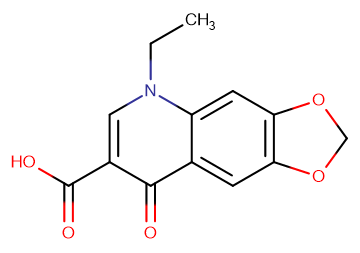
Oxolinic acid
CAS No. 14698-29-4
Oxolinic acid( NSC 110364 | Urinox )
Catalog No. M12008 CAS No. 14698-29-4
Oxolinic acid is a potent inhibitor of DNA gyrase and DNA synthesis, lead to DNA cleavage when extracted chromosomes are incubated with sodium dodecyl sulfate.
Purity : >98% (HPLC)
 COA
COA
 Datasheet
Datasheet
 HNMR
HNMR
 HPLC
HPLC
 MSDS
MSDS
 Handing Instructions
Handing Instructions
| Size | Price / USD | Stock | Quantity |
| 500MG | 41 | In Stock |


|
| 1G | 43 | In Stock |


|
Biological Information
-
Product NameOxolinic acid
-
NoteResearch use only, not for human use.
-
Brief DescriptionOxolinic acid is a potent inhibitor of DNA gyrase and DNA synthesis, lead to DNA cleavage when extracted chromosomes are incubated with sodium dodecyl sulfate.
-
DescriptionOxolinic acid is a potent inhibitor of DNA gyrase and DNA synthesis, lead to DNA cleavage when extracted chromosomes are incubated with sodium dodecyl sulfate.(In Vitro):Oxolinic acid (2-5 ug/mL) inhibits 115 strains of E. coli.Oxolinic acid (0-31 ug/mL) inhibits 94 % of the 44 strains of Proteus mirabilis .Oxolinic acid (>5 ug/mL) inhibits all strains of Strept. Faecalis.Oxolinic acid (>2 ug/mL) causes chromosomal DNA supercoiling to decrease in the two wild-type E. coli K-12 strains tested, DM4100 and NI747.Oxolinic acid reduces chromosomal DNA supercoiling and inhibits RNA synthesis in E. coli. (In Vivo):Oxolinic acid (32 mg/kg; i.p.) induces hyperactivity in mice.
-
In VitroOxolinic acid (2-5 ug/mL) inhibits 115 strains of E. coli.Oxolinic acid (0-31 ug/mL) inhibits 94 % of the 44 strains of Proteus mirabilis .Oxolinic acid (>5 ug/mL) inhibits all strains of Strept. Faecalis.Oxolinic acid (>2 ug/mL) causes chromosomal DNA supercoiling to decrease in the two wild-type E. coli K-12 strains tested, DM4100 and NI747.Oxolinic acid reduces chromosomal DNA supercoiling and inhibits RNA synthesis in E. coli.
-
In VivoOxolinic acid (32 mg/kg; i.p.) induces hyperactivity in mice. Animal Model:Male Swiss albino CD1 mice (22-25 g) Dosage:16 mg/kg, 32 mg/kg, 64 mg/kg, 128 mg/kg Administration:Intraperitoneal injection Result:Stimulated the horizontal activity of mice, culminated at the 32 mg/kg dose but disappeared at the highest tested dose, 128 mg/kg.
-
SynonymsNSC 110364 | Urinox
-
PathwayGPCR/G Protein
-
TargetAntibacterial
-
Recptorbacterial DNA gyrase| DNA synthesis| dopamine uptake
-
Research AreaInfection
-
Indication——
Chemical Information
-
CAS Number14698-29-4
-
Formula Weight261.24
-
Molecular FormulaC13H11NO5
-
Purity>98% (HPLC)
-
SolubilityWater: 0.003mg/L
-
SMILESO=C(C1=CN(CC)C2=CC(OCO3)=C3C=C2C1=O)O
-
Chemical Name5-Ethyl-8-oxo-[1,3]dioxolo[4,5-g]quinoline-7-carboxylic acid
Shipping & Storage Information
-
Storage(-20℃)
-
ShippingWith Ice Pack
-
Stability≥ 2 years
Reference
1. Jariyawat S, et al. J Pharmacol Exp Ther. 1999 Aug;290(2):672-7.
molnova catalog



related products
-
piperacillin
Piperacillin is a semisynthetic penicillin with wide spectrum of antimicrobial activity(particularly pseudomonas strains.
-
Resazurin sodium sal...
Resazurin sodium salt is a blue non-fluorescent dyeis widely used as a metabolic indicator for living cells.
-
Bio-AMS
Bio-AMS is a chemical inhibitor of Mycobacterium tuberculosis biotin protein ligase ( MtBPL) with Kd of 0.865 nM.



 Cart
Cart
 sales@molnova.com
sales@molnova.com


